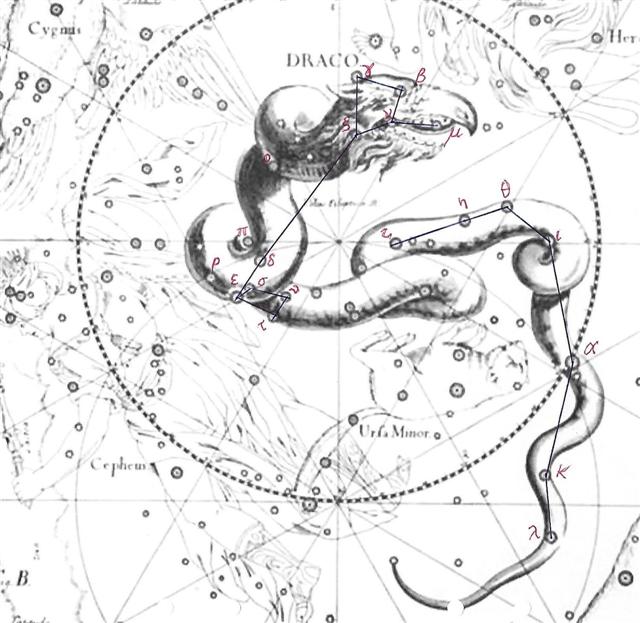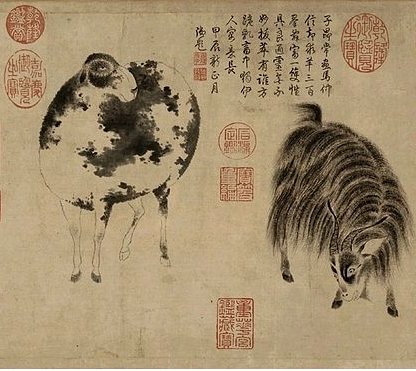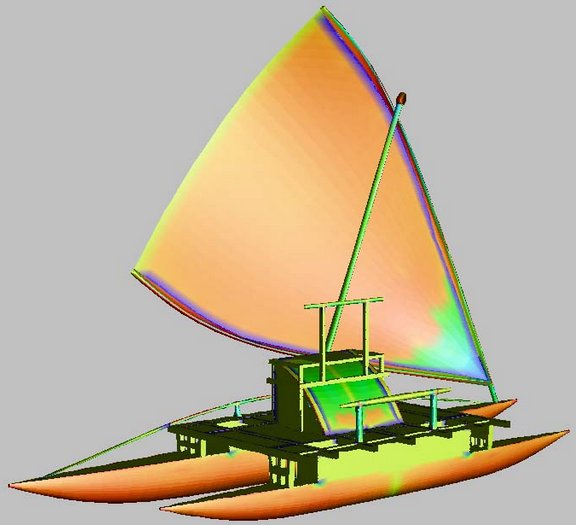321. The Polynesians usually regarded the Pleiades as the sign to be observed in order to find the beginning of the year:
... In view of the almost universal prevalence of the Pleiades year throughout the Polynesian area it is surprising to find that in the South Island and certain parts of the North Island of New Zealand and in the neighboring Chatham Islands, the year began with the new Moon after the early morning rising, not of the Pleiades, but of the star Rigel in Orion ...
The Star King after Hamal was connected with Alcyone (in the Pleiades) which probably Manuscript E had given the name Tangaroa A Oto Uta:
|
ko oto uta |
ariki motongi |
1 |
Hamal |
|
ko tangaroa.a oto uta |
ariki motongi |
2 |
Alcyone |
|
ko tiki hati.a tangaroa |
ariki motongi |
3 |
|
|
ko roroi.a tiki hati |
ariki motongi |
4 |
|
|
ko tuu kumā.a roroi |
ariki motongi |
5 |
|
|
ko ataranga.a tuu kumā |
ariki motongi |
6 |
|
|
ko harai.a ataranga |
ariki motongi |
7 |
|
|
ko taana.a harai |
ariki motongi |
8 |
|
|
ko matua.a taana |
ariki motongi |
9 |
|
|
ko hotu.a matua |
ariki motongi |
10 |
Antares |
| O maori te ariki nei. etahi te angahuru. ko maori. te ingoa o te kainga. ko marae renga te ingoa. o te maara noho o te ariki.nui.ko ma rae tohia te rua maara noho o te ariki. |
I have located Alcyone early in line Cb2:
|
... Returning now to the C text we can perceive how glyph 396 once upon a time could have represented the last day of January, viz. in a time-frame 79 (= 9 weeks + 16) precessional days earlier than that of rongorongo (1842 AD). Notably the number of glyph positions on the G tablet is 472 (which 'happens to be' equal to 393 + 63 + 16). And (396 - 3 =) 393 + 63 = 456 (= 24 * 19 = 396 + 60 = 365 + 91 = 365 + 107 - 16). |
| 1-28 (408 - 79 + 64 = 393) |
1-29 |
1-30 (45 - 15) |
1-31 (396 = 48 * 7 + 60) |
| FEBR 12 (408 = 365 + 43) |
13 |
2-14 (45) |
15 |
 |
 |
 |
 |
| Cb1-1 (393) |
Cb1-2 |
Cb1-3 |
Cb1-4 (396) |
| E tupu - ki roto - o te hau tea |
ki te henua - te maro |
| Al Sharatain-1 / Ashvini-1 / Bond-16 (Dog) / Mahrū-sha-rishu-ku-1 (Front of the Head of Ku)
SEGIN = ε Cassiopeia, MESARTHIM = γ Arietis, ψ Phoenicis (27.2),
SHERATAN (Pair of Signs) = β Arietis, φ Phoenicis (27.4) |
ι Arietis (28.0), λ Arietis (28.2), υ Ceti (28.8) |
ALRISHA (The Knot) = α Piscium, χ Phoenicis (29.2), ALAMAK (Caracal) = γ Andromedae (29.7) |
Arku-sha-rishu-ku-2 (Back of the Head of Ku)
2h (30.4)
κ Arietis (30.3), HAMAL (Sheep) = α Arietis (30.5)
ALKES (α Crateris)
|
| April 17 (107 = 80 + 27) |
18 |
19 (*29) |
(396 + 79 = 475 = 472 + 3) |
|
... There were 10 Star Kings before the Deluge and the first one of them was Hamal (α Arietis): ... Strassmeier and Epping, in their Astronomishes aus Babylon, say that there its stars formed the third of the twenty-eight ecliptic constellations, - Arku-sha-rishu-ku, literally the Back of the Head of Ku, - which had been established along that great circle milleniums before our era; and Lenormant quotes, as an individual title from cuneiform inscriptions, Dil-kar, the Proclaimer of Dawn, that Jensen reads As-kar, and others Dil-gan, the Messenger of Light. George Smith inferred from the tablets that it might be the Star of the Flocks; while other Euphratean names have been Lu-lim, or Lu-nit, the Ram's Eye; and Si-mal or Si-mul, the Horn star, which came down even to late astrology as the Ram's Horn. It also was Anuv, and had its constellation's titles I-ku and I-ku-u, - by abbreviation Ku, - the Prince, or the Leading One, the Ram that led the heavenly flock, some of íts titles at a different date being applied to Capella of Auriga. Brown associates it with Aloros, the first of the ten mythical kings of Akkad anterior to the Deluge, the duration of whose reigns proportionately coincided with the distances apart of the ten chief ecliptic stars beginning with Hamal, and he deduces from this kingly title the Assyrian Ailuv, and hence the Hebrew Ayil; the other stars corresponding to the other mythical kings being Alcyone, Aldebaran, Pollux, Regulus, Spica, Antares, Algenib, Deneb Algedi, and Scheat ... |
 |
| CLOSE TO THE FULL MOON: |
| MUPHRID (Solitary Star) = η Bootis (210.1), ζ Centauri (210.3) |
φ Centauri (211.0), υ¹ Centauri (211.1), υ² Centauri (211.8), τ Virginis (211.9) |
AGENA (At the Knee) = β Centauri (212.1), θ Apodis (212.5), THUBAN (Dragon) = α Draconis (212.8) |
14h (213.1)
π Hydrae, χ Centauri (213.0), MENKENT (Shoulder of the Centaur) = θ Centauri (213.1) |
| Oct 17 (290 = 210 + 80) |
18 |
19 |
20 (*213) |
| 'Sept 20 |
21 (264) |
EQUINOX |
23 |
| "Sept 6 |
7 (250 = 264 - 14) |
8 (*171 = *212 - *41) |
Hora Nui 9 |
| AUG 14 (*146) |
15 (227 → π) |
16 (45 + 183) |
17 |
 |
| 20 |
2-21 (417 = 432 - 15) |
2-22 (68 - 15 = 53) |
2-23 (54) |
| MARCH 8 (432 = 67 + 365) |
9 (68 = 45 + 23) |
10 |
 |
 |
 |
| Cb2-1 (25) |
Cb2-2 |
Cb2-3 |
| Eaha te honu kua tupu |
i to maitaki - o te hau tea |
te hono huki - maro |
| σ Persei (51.6) |
no star listed (52) |
ψ Persei (53.1)
ACRUX (α CRUCIS)
|
| May 11 |
12 (132) |
13 |
| "Febr 13 (409 = 432 - *23) |
2-14 (365 - 80 + 45 = *330) |
Tehetu'upú 15 |
| CLOSE TO THE FULL MOON: |
| NUSAKAN (Pauper) = β Cor. Bor. (234.0), κ¹ Apodis (234.3), ν Bootis (234.7), ζ Librae (234.9) |
θ Cor. Borealis (235.3), γ Lupi (235.6), GEMMA = α Cor. Bor., ZUBEN ELAKRAB = γ Librae, QIN = δ Serpentis, ε Tr. Austr. (235.7), μ Cor. Borealis (235.8), υ Librae (235.9) SIRRAH (α Andromedae)
|
φ Bootis (236.2), ω Lupi, τ Librae (236.3), ψ¹ Lupi (236.7), ζ Cor. Borealis (236.9) |
|
... In other words, the ancient Druidic religion based on the oak-cult will be swept away by Christianity and the door - the god Llyr - will languish forgotten in the Castle of Arianrhod, the Corona Borealis. This helps us to understand the relationship at Rome of Janus and the White Goddess Cardea who is ... the Goddess of Hinges who came to Rome from Alba Longa. She was the hinge on which the year swung - the ancient Latin, not the Etruscan year - and her importance as such is recorded in the Latin adjective cardinalis - as we say in English 'of cardinal importance - which was also applied to the four main winds; for winds were considered as under the sole direction of the Great Goddess until Classical times ... |
| Nov 10 (314 = *234 + 80) |
11 |
12 (*236) |
| 'Oct 14 (*207 = *234 - *27) |
15 (288) |
16 |
| Hora Nui 30 (273) |
"Oct 1 |
Tagaroa Uri 2 (*236 - *41) |
| SEPT 7 (250) |
8 |
9 (*172 = *236 - *64) |
| 2-24 (420 = 6 * 70) |
2-25 |
2-26 |
2-27 (58) |
| MARCH 11 |
12 (436) |
13 (72 = 360 / 5) |
3-14 (73) |
 |
 |
 |
 |
| Cb2-4 (420 = 7 * 60) |
Cb2-5 (29) |
Cb2-6 |
Cb2-7 (58 - 27 = 31) |
| te ua |
koia ra |
kua tuku ki to mata - ki tona tukuga |
e kiore - henua - pa rei |
| δ Persei (54.7) |
Al Thurayya-27 (Many Little Ones) / Krittikā-3 (Nurses of Kārttikeya) / TAU-ONO (Six Stones)
ATIKS = ο Persei, RANA (Frog) = δ Eridani (55.1), CELAENO (16 Tauri), ELECTRA (17), TAYGETA (19), ν Persei (55.3), MAIA (20), ASTEROPE (21), MEROPE (23) (55.6) |
Hairy Head-18 (Cockerel) / Temennu-3 (Foundation Stone)
ALCYONE (56.1), PLEIONE (28 Tauri), ATLAS (27 Tauri) (56.3) |
MENKHIB (Next to the Pleiades) = ζ Persei (57.6)
PORRIMA (γ Virginis)
|
 |
| May 14 (*378 + 41 = *419) |
15 (500 = 365 + 135) |
16 (136) |
17 |
| 'April 17 (107) |
18 |
19 |
20 (*30) |
| Tehetu'upú 16 (*378) |
"Febr 17 (459 = 500 - 41) |
18 (95 = 136 - 41) |
19 |
| CLOSE TO THE FULL MOON: |
| κ Librae (237.2), ι Serpentis (237.4), ψ² Lupi, ρ Oct. (237.5), γ Cor. Borealis, η Librae (237.7), COR SERPENTIS = α Serpentis (237.9) |
π Cor. Borealis, UNUK ELHAIA (Necks of the Serpents) = λ Serpentis (238.1), CHOW = β Serpentis (238.6) |
κ Serpentis (239.3), δ Cor. Borealis, TIĀNRŪ = μ Serpentis (239.5), χ Lupi, (239.6), ω Serpentis (239.7), BA (= Pa) = ε Serpentis, χ Herculis (239.8). κ Cor. Borealis, ρ Serpentis (239.9) |
λ Librae (240.0), β Tr. Austr. (240.3), κ Tr. Austr. (240.4), ρ Scorpii (240.8) |
| Nov 13 (*237) |
14 |
15 |
16 (320) |
| 'Oct 17 (290) |
18 |
19 |
20 (*213 = *240 - *27) |
| "Oct 3 (276) |
4 |
Tagaroa Uri 5 |
6 (*199 = *240 - *41) |
| SEPT 10 (*173) |
11 |
12 |
13 (256 = 320 - 64) |
|
... The correspondence between the winter solstice and the kali'i rite of the Makahiki is arrived at as follows: ideally, the second ceremony of 'breaking the coconut', when the priests assemble at the temple to spot the rising of the Pleiades, coincides with the full moon (Hua tapu) of the twelfth lunar month (Welehu). In the latter eighteenth century, the Pleiades appear at sunset on 18 November. Ten days later (28 November), the Lono effigy sets off on its circuit, which lasts twenty-three days, thus bringing the god back for the climactic battle with the king on 21 December, the solstice (= Hawaiian 16 Makali'i). The correspondence is 'ideal' and only rarely achieved, since it depends on the coincidence of the full moon and the crepuscular rising of the Pleiades ... |
Alcyone (*56) was rising heliacally in May 16 (136), in the day after Tau-ono (6 'stones') had completed the old cycle - stretching for 365 + 135 = 500 days. This could have been alluded to when the 6 remaining Explorers had carried poor Kuukuu down into his hole (pú as in Hetu'upú):
... They put the injured Kuukuu on a stretcher and carried him inland. They prepared a soft bed for him in the cave and let him rest there. They stayed there, rested, and lamented the severely injured Kuukuu. Kuukuu said, 'Promise me, my friends, that you will not abandon me!' They all replied, 'We could never abandon you!' They stayed there twenty-seven days in Oromanga. Everytime Kuukuu asked, 'Where are you, friends?' they immediately replied in one voice, 'Here we are!' They all sat down and thought. They had an idea and Ira spoke, 'Hey, you! Bring the round stones (from the shore) and pile them into six heaps of stones!' One of the youths said to Ira, 'Why do we want heaps of stone?' Ira replied, 'So that we can all ask the stones to do something.' They took (the material) for the stone heaps (pipi horeko) and piled up six heaps of stone at the outer edge of the cave. Then they all said to the stone heaps, 'Whenever he calls, whenever he calls for us, let your voices rush (to him) instead of the six (of us) (i.e., the six stone heaps are supposed to be substitutes for the youths). They all drew back to profit (from the deception) (? ki honui) and listened. A short while later, Kuukuu called. As soon as he had asked, 'Where are you?' the voices of the stone heaps replied, 'Here we are!' All (the youths) said, 'Hey, you! That was well done!' ...
... The Mahabharata insists on six as the number of the Pleiades as well as of the mothers of Skanda and gives a very broad and wild description of the birth and the installation of Kartikeya 'by the assembled gods ... as their generalissimo', which is shattering, somehow, driving home how little one understands as yet. The least which can be said, assuredly: Mars was 'installed' during a more or less close conjunction of all planets; in Mbh. 9.45 (p. 133) it is stressed that the powerful gods assembled 'all poured water upon Skanda, even as the gods had poured water on the head of Varuna, the lord of waters, for investing him with dominion'. And this 'investiture' took place at the beginning of the Krita Yuga, the Golden Age ...
 |
|
COR SERPENTIS |

Janus had a dark face oriented backwards and a light face oriented forwards. This could have corresponded to January (the last month) followed by February (the first month).
... At the beginning of 44 B.C. - when Ceasar was still alive - the Senate decided to raise statues of him in all the temples and to sacrifice to him on his birthday in the month Quintilis, which in honour of him was renamed July. He was raised to the status of a god (among the other gods of the state) under the name Jupiter Julius. Marcus Antonius, who this year was consul together with Ceasar, became high priest and responsible for the ceremonies. In the middle of February, at the time of the old feast of Lupercalia, he ran around naked, and whipped the Roman ladies with thongs made from goat-skin [februa], in order to promote their fertility ...


Similarly could Hamal have been regarded as standing at the end of the old Pleiades year with Alcyone at its beginning. 396 + 26 = 422 = 393 + 29:
| 1-28 (408 - 79 + 64 = 393) |
2 |
1-31 (48 * 7 + 60 = 396) |
25 |
2-26 |
 |
 |
 |
|
Cb1-1 (393) |
Cb1-4 (396) |
Cb2-6 (393 + 29) |
|
SHERATAN |
HAMAL |
ALCYONE |
... At the time of the loading of the emigrant canoe, Hotu Matua ordered his assistant Teke to take a (stone) figure (moai) named 'Oto Uta' on board the canoe, along with the people (aniva) who were emigrating. However, the figure was left behind 'out in the bay' (E:73) ...
At the opposite side of Janus was the Ship ('canoe'), and Alcyone was the daughter of Pleione (as in the Pleiades):
... another Alcyone, daughter of Pleione, 'Queen of Sailing', by the oak-hero Atlas, was the mystical leader of the seven Pleiads. The heliacal rising of the Pleiads in May marked the beginning of the navigational year; their setting marked its end when (as Pliny notices in a passage about the halcyon) a remarkably cold North wind blows ...
.jpg)
... The first god's house in the temple was the body of Ta'aroa's own person, and it became a model for all other god's houses. One day Ta'aroa let himself go into a trance and his spirit stood away in space while his body floated in the sea, then he said to his daughters: 'Oh, girls! How many canoes are there at sea?' And the daughters replied: 'It is like one, it is like one!' Then Ta'aroa's spirit said: 'Who can it be?' And they answered: 'It is thyself assuredly!' ...

|












.jpg)
